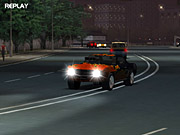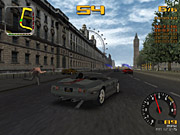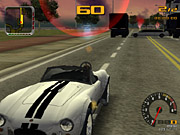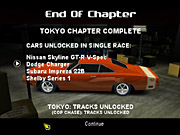Infogrames' long-lived Test Drive games is still around, in spite of the fact that the series has never really earned a great deal of critical acclaim. From the onset, the latest iteration of this surprisingly resilient series seems to offer little more than its ancestors. Yet there's something about this version of Test Drive--entitled simply "Test Drive"--that puts it ahead of its predecessors. Despite its unrealistic physics, repetitive racing, and insufficient options, the game can, at times, be surprisingly enjoyable. Considering how limited the selection of foot-to-the-floor arcade racers has been lately, Test Drive seems like a much more attractive prospect than it otherwise might have.

Developed by Pitbull Syndicate--the same studio responsible for the three most recent Test Drive games (not including Test Drive Off-Road or Le Mans)--the latest game in the series follows the familiar Test Drive formula of late-model street-legal cars, impossible speeds, and public thoroughfares. Ultimately, you'll have an opportunity to drive no fewer than 20 real-life automobiles, including exotic cars such as the Lotus Elise and the Jaguar XK-R; horsepower-infused monsters such as the Shelby Cobra and the Chevy Corvette; and traditional muscle cars such as an early '70s Dodge Charger or the Plymouth Barracuda.
And even though Test Drive has only half the number of drivable cars as the previous game in the series, Test Drive 6, the quality and performance of the cars in Test Drive are considerably improved. Whereas Test Drive 6's vehicles handled in a decidedly jumpy, digital manner that often veered drivers spastically into the nearest abutment, Test Drive's cars react in a smooth, graduated fashion far more suited to a racing game. You can even lock your brakes or enter a controlled four-wheel drift. But it should be noted that Test Drive's cars don't handle realistically--driving one will seem more like taking the wheel of a speedboat, rather than a vehicle on dry land.
Fortunately, the latest game in the Test Drive series has generally wide and accommodating roadways to keep you off the guardrails and obstacles--a considerable improvement on the tracks of previous games, which featured slim, snaking courses that forced you to collide continually with barriers and other annoyances. However, you'll still run into your fair share of traffic cones, traffic barriers, peripheral traffic, lamp standards, and other assorted roadside debris in Test Drive, since the game is loaded with movable objects, immobile objects, and superhuman pedestrians who somehow always manage to leap out of your path at the last second.

Unfortunately, Test Drive does feature one of the most annoying aspects of the series--the so-called "rubber-band AI," which causes your opponents to always perform in accordance with your current speed and situation. If you're driving in a closely knit pack and suddenly lose several seconds by entangling yourself with an oncoming car or obstacle, for some bizarre reason, the entire pack ahead of you slows to a virtual standstill waiting for you to regain the lost ground. Likewise, no matter how well you drive in a given event, you'll never really gain a substantial lead on your opponents.
Graphically, Test Drive looks impressive. Each of the game's four scenic and distinct environments features a broad selection of roadways, ranging from the famous hills of San Francisco to the freeway mazes of Tokyo and the dense, tight surroundings of London and Monaco. In addition, none of the four cities confines you to a specific type of thoroughfare. In San Francisco, for example, you'll hurtle through the air in the undulating downtown section, hit top speed along the curvy highways outside of town, and flash over the Golden Gate Bridge. In Tokyo, you'll pick your way nimbly along cherry-blossom-lined passageways before reaching terminal velocity on the wide adjoining arteries, though you'll usually end up covering the same sections of pavement several times before moving on, which can seem repetitive.
One of the most obvious improvements in Test Drive is the visual quality of its vehicles and scenery. Whereas Test Drive 6's cars looked like nothing more than cheap toys, Test Drive's cars are more detailed and impressively realistic. In addition, the game features realistic perspectives while driving, rather than the strange, elongated views and skewed camera angles that were present in the previous games. The game also features a replay mode that lets you watch yourself and your opponents tear through the game's jam-packed city courses.

Test Drive also has a number of other new features, including a storyline. In the central Test Drive mode, mysteriously named "underground," you'll assume the identity of ultracool wheelman Dennis Black. Hired by a wealthy and only somewhat enigmatic employer to engage in a succession of illegal but highly organized street races, you'll soon find yourself battling fender-to-fender on the streets of San Francisco with several other top-ranked underground racers. You'll run a total of 10 sub-six-minute events in the City by the Bay before moving on to 10 more in Tokyo and more still in London and Monaco, unlocking cars and tracks along the way for use in the game's single race modes.
Each sequence of underground events consists of a variety of race types. The vast majority are point-to-point or circuit affairs conducted through a web of urban and rural streets and highways looping in and around each city. In these races, you must finish in the top three of six or face banishment from the secretive league. You'll also receive an occasional personal challenge from one or more members of your racing fraternity to a two-driver circuit or drag race, with the winner emerging with his adversary's automobile. Such communication is delivered in combination with an array of good-natured bantering via a two-way video hookup installed in your car. The underground mode sounds interesting, but it's not perfect; since you can immediately restart with no penalty, there's no real element of risk. Also, the chatter you'll exchange with your opponents is completely scripted, and finally, it's a little too easy.
Test Drive is also woefully short on peripheral amenities and options. For instance, the game lacks features like a garage or parts-upgrade facility. In fact, with the exception of being able to alter the base color of your car's body at a rudimentary paint shop, you can't enact any modifications. You won't find a rearview mirror, a visible cockpit, or any trace of body or mechanical damage in Test Drive either. The game does offer day and night races, but it does not support weather variables, and multiplayer racing is restricted to hot-seat play: two players on a single computer. However, Test Drive does offer several alternatives to the central undergound mode. Single race options include linear point-to-point events, cop chases, drag races, and navigation challenges, each of which places you in a distinctive situation and requires you to perform specific tasks.

Test Drive's audio isn't perfect either. The game's tire noise is hidden, and its incidental cross-traffic engine sounds are erratic. Additionally, we auditioned the game on two systems and noticed sound effect dropouts on each--a rather unfortunate problem for a racing game to have, since you often rely upon the note of your engine to decide when and where to shift gears or otherwise adjust your speed. As is common for the Test Drive series, the latest game features an impressive and instantly recognizable selection of modern urban and hard rock selections from artists such as DMX and Ja Rule. Parents should note that some songs feature moderately objectionable lyrics.
Test Drive seems sure to disappoint fans of realistic racing, and it's not exactly the pinnacle of arcade-style driving either. However, the game represents a considerable improvement over its predecessors. If you can live with Test Drive's shortcomings and you relish the thought of ridiculous high speeds and occasional collisions, you might want to give it a try.